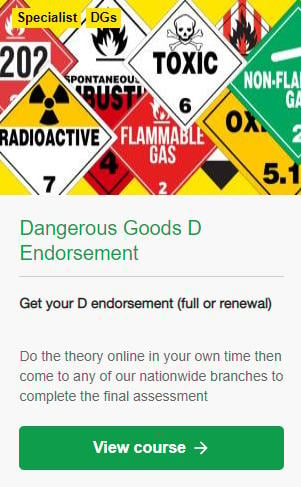This article explains what hazardous goods are, how to transport them, whether you need a D endorsement on your drivers licence to do so, and how to get a D endorsement.
What are hazardous goods?
Hazardous or dangerous goods are goods that are corrosive, flammable, explosive, toxic, infectious or environmentally hazardous, or containers that have held these types of goods.
New Zealand’s Land Transport Rule: Dangerous Goods 2005 is based on the United Nations Recommendations on the transport of dangerous goods and outlines in detail what you are allowed to carry and how it must be carried. You can read the full specifications here.
How to remember the dangerous goods classifications
You can remember the dangerous goods classifications using the following mnemonic:
Every Golfer Loves Swinging Outside; The Right Club Matters.
The first letter of each word is the first letter of the 9 classifications of dangerous goods:
- Every = Explosives
- Golfer = Gases
- Loves = Liquids
- Swinging = Solids
- Outside = Oxidisers and organic peroxides
- The = Toxic substances
- Right = Radioactives
- Club = Corrosives
- Matters = Miscellaneous.
Domestic or recreational use
If you are transporting dangerous goods for domestic or recreational use then you don’t need a D endorsement, but you still need to comply with safe practices for moving the goods themselves.
You (the driver) must:
- ensure that all goods are properly packaged and identified so that in the case of an accident you don’t put emergency services at risk
- segregate incompatible dangerous goods so that you don’t cause any leakage or chemical reaction
- secure the load on or in the vehicle so that there is no danger of it falling off when moving.
Commercial use
If you are transporting dangerous goods for commercial purposes – i.e. tools-of-trade, agriculture, transport or another commercial purpose – then you may need a D endorsement if the quantities are more than the limits in schedule 1 of the rule. Some sample limits before you need a D endorsement are:
- up to 250kg of cartridges and small arms
- up to 100 litres of UN1977 nitrogen refrigerated liquid
- up to 5kg of solids/powders or 5 litres of organic peroxides Type B.
Carrying small quantities of dangerous goods
If you don’t carry the goods for hire or reward, and the quantity carried is under the limits in schedule 1 of the rule then the driver is responsible for:
- Securing the load on the vehicle – a spillage can be extremely dangerous for people and the environment
- Ensuring that all dangerous goods are properly packaged and identified so that in an emergency, emergency services are aware of what they are dealing with and can take appropriate measures to contain any spill or reaction, and to clear bystanders out of the way
- Carrying emergency response information
- Adhering to and ensuring safe handling practices and emergency procedures, including segregating incompatible goods to avoid punctures, spillages, leakages and chemical reactions.
If you carry goods for hire or reward (i.e. you are a courier or transport services operator) then there are specific restrictions and responsibilities set out in the rule:
Dangerous goods in limited quantities and consumer commodities: these are low- and medium-danger goods in small primary containers packed specifically for transport in strong outer packaging. Some of the controls are relaxed and are set out in section 2 of the rule.
Small packages of dangerous goods in limited quantities or consumer commodities: See clause 2.4 in the rule for a definition of small packages. If the total quantity does not exceed 50kg they may be transported without a dangerous goods declaration, placards or signage on the vehicle or drivers having a D (dangerous goods) endorsement on their licence. Some dangerous goods are not allowed to be transported as small packages. Check the rule for further clarification.
An amendment to the rule in 2010 introduced new provisions for dangerous goods in excepted quantities. For example, low-danger products in small quantities, such as 30ml of perfume.
Carrying large quantities of dangerous goods
If you carry goods in quantities more than set out in schedule 1 of the rule then you must comply with the rule’s requirements for driver licence endorsement, placarding/signage, documentation, packaging and identification, emergency response and segregation of incompatible hazardous goods.
Even if you are carrying the goods for recreational purposes, if the quantities are above the limits, you must comply with the rule’s requirements.
Technical information
The list of hazardous goods supplied by NZTA is:
- ammunition and fireworks
- aerosol canisters
- LPG cylinders
- oxyacetylene cylinders
- compressed air cylinders for scuba diving
- flammable liquids such as petrol, kerosene, methylated spirits, turpentine, thinners, solvent-based paints and epoxy resin
- hardener for epoxy resin
- some swimming pool chemicals
- some commercial and household cleaning products, such as dishwasher detergents
- some garden care products
- diesel.
This list isn’t exhaustive and there are a great many chemicals and other products that fall under the hazardous or dangerous goods category, as specified in the rule.
If you are an importer, manufacturer or distributor you may need to understand and provide information on the classification of the dangerous goods, how to package them, specifications for labelling, and the list of UN numbers and proper shipping names.
A UN number is a 4-digit number that specifies a hazardous substance.
Placards, labelling and signage
All packages containing dangerous goods must be marked or labelled with the appropriate signs to inform those who handle them what precautions must be taken. These placards may also have to appear on the outside of the vehicle as well as the packaging.
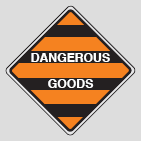
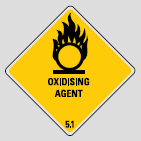
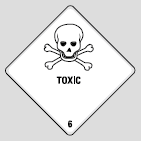
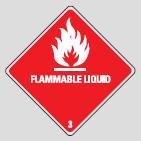
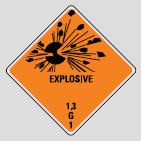
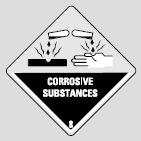
You can see more examples of placards here.
The goods will also be identified by a UN number and possibly other labels or marks. For example, products toxic to aquatic life have a diamond-shaped label with a symbol of a dead fish and tree.
For transporting radioactive goods, refer to this page.
Getting a D endorsement on your driver licence
If you transport dangerous goods for hire or reward, or you transport them in greater quantities than the limits set out in the rule, you need a D endorsement.
You don’t need a D endorsement if you transport hazardous goods for recreational or domestic purposes, the quantities are under the limits set out in the rule, or if the goods you are carrying are classified UN 3077 or UN 3082.
Making an application
You must first successfully complete a course from an approved course provider, for example, you can do a D endorsement course here.
Apply at your nearest Transport Agency driver licensing agent taking:
- a completed DL19 form (download it here)
- your NZ passport or photographic licence
- two other acceptable forms of evidence of identity (NZ passport, driver’s licence, firearms licence, birth certificate, citizenship certificate, overseas passport, refugee travel document, emergency travel document)
- your course certificate (must be no more than 60 days old)
- a form of payment for the $44 fee (cheque, cash, EFTPOS)
- an eyesight certificate (or be prepared to pass an eyesight screening test at the licencing agent).
Your D endorsement will be valid for 5 years. You can renew it up to 5 years after it has expired by doing a renewal course.

